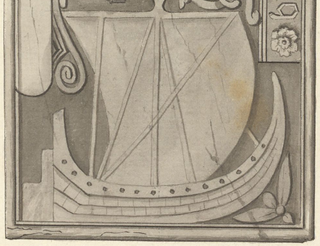 W
WThe birlinn was a wooden vessel propelled by sail and oar, used extensively in the Hebrides and West Highlands of Scotland from the Middle Ages on. Variants of the name in English and Lowland Scots include "berlin" and "birling". The Gaelic term may derive from the Norse byrðingr. It has been suggested that a local design lineage might also be traceable to vessels similar to the Broighter-type boat, equipped with oars and a square sail, without the need to assume a specific Viking design influence. It is uncertain, however, whether the Broighter model represents a wooden vessel or a skin-covered boat of the currach type. The majority of scholars emphasise the Viking influence on the birlinn.
 W
WThe bucentaur was the state barge of the doges of Venice. It was used every year on Ascension Day up to 1798 to take the doge out to the Adriatic Sea to perform the "Marriage of the Sea" – a ceremony that symbolically wedded Venice to the sea.
 W
WA cog is a type of ship that first appeared in the 10th century, and was widely used from around the 12th century on. Cogs were clinker-built, generally of oak. These vessels were fitted with a single mast and a square-rigged single sail. They were mostly associated with seagoing trade in north-west medieval Europe, especially the Hanseatic League. Typical seagoing cogs ranged from about 15 to 25 meters in length, with a beam of 5 to 8 meters and were 30–200 tons burthen. Cogs were rarely as large as 300 tons although a few were considerably larger, over 1,000 tons.
 W
WThe Kvalsund ship is a late 7th century rowing ship, discovered embedded in a marsh on Kvalsund in Herøy, Møre og Romsdal near Ålesund in 1920, along with a smaller rowboat called Kvalsundferingen. It is of an earlier construction than the Oseberg and Gokstad ship, both of which date to the ninth century. The Kvalsund ship dates to 690AD.
 W
WOrmrinn Langi in Old Norse Ormen Lange in Norwegian, Ormurin Langi in Faroese was one of the most famous of the Viking longships. It was built for the Norwegian King Olav Tryggvason, and was the largest and most powerful longship of its day. In the late 990s King Olav was on a "Crusade" around the country to bring Christianity to Norway. When he was traveling north to Hålogaland he came to a petty kingdom in today's Skjerstad, where the king named Raud the Strong refused to convert to Christianity. A battle ensued, during which Saltstraum, a maelstrom that prevented reinforcements to the king's men, forced King Olav to flee. He continued up north but returned some weeks later when the maelstrom had subsided. Olav won the battle, captured Raud, and gave him two choices: die or convert. The Sagas say that Olav tried to convert him but Raud cursed the name of Jesus, and the King became so enraged that he stuck a kvanstilk down his throat and shoved a snake into it, then a burning iron to force the snake down his throat. The snake ate its way out of the side of the torso of Raud and killed him. After the victory Olav confiscated Raud's riches, not least of which was Raud's ship, which he rechristened Ormen. He took it to Trondheim and used it as a design for his own new ship, which he made a couple of "rooms" longer than Ormen and named Ormen Lange.
 W
WThe Snape Anglo-Saxon Cemetery is a place of burial dated to the 6th century AD located on Snape Common, near to the town of Aldeburgh in Suffolk, Eastern England. Dating to the early part of the Anglo-Saxon Era of English history, it contains a variety of different forms of burial, with inhumation and cremation burials being found in roughly equal proportions. The site is also known for the inclusion of a high status ship burial. A number of these burials were included within burial mounds.
 W
WA Strug is a type of flat-bottomed boat which was in use primarily in Russia from the 11th - 18th centuries, for the transport of people and cargo as well as military uses. Designs varied somewhat between different regions of Russia, with typical parameters being a length of 20-45 meters, a width of 4-10 meters, and from 6-20 oars. In some cases both the bow and stern were similarly pointed. Many were equipped with a removable mast and small straight sail, which could be used when the wind permitted, and some models also had a small cabin.
 W
WThe White Ship was a vessel transporting many nobles, including the heir to the English throne, that sank in the Channel during a trip from France to England near the Normandy coast off Barfleur, on 25 November 1120. Only one of approximately 300 people aboard survived, a butcher from Rouen. Those who drowned included William Adelin, the only legitimate son and heir of Henry I of England, his half-sister Matilda of Perche, his half-brother Richard of Lincoln, the earl of Chester Richard d'Avranches, and Geoffrey Ridel. William Adelin's death led to a succession crisis and a period of civil war in England from 1135–1153 known as the Anarchy.